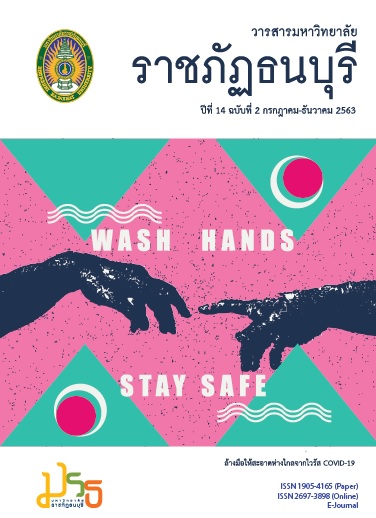Fear Factors in Speaking English of Nursing Students: A Comparative Study of atchathani University and Boromarajonani College of Nursing Sanpasithiprasong
คำสำคัญ:
English speaking, Fear, Nursing studentsบทคัดย่อ
This study aimed to compare the fear factors in speaking English of nursing students encounter while studying English. A comparative study from the previous study results, conducted with nursing students at Ratchathani University (RTU) and nursing students at Boromarajonani College of Nursing Sanpasithiprasong (BCNS), carried out in the 2014 and 2016 academic year. Statistics used to analyze the resulting data included frequency, percentage, mean, and standard deviation. The Independent t-test was used to compare the overall results of each group. There was not a significant difference in the scores for Nursing students at RTU (M = 46.93%, S.D.= 7.86) and scores for Nursing students at BCNS (M = 46.46%, S.D.= 18.24) at the condition of t(38) = 0.106, and p = 0.916. The study results led school administrators to concern about the fear rate and fear factors in speaking English of nursing students and prepare the appropriate lessons to improve English speaking and decrease the students' fear rate.
Downloads
เอกสารอ้างอิง
Berman, R., & Cheng, L. (2001). English academic language skills: Perceived difficulties by undergraduate and graduate students, and their academic achievement. Canadian Journal of Applied Linguistics. pp. 25-40.
Chacon, A. E. (2000). Survey of International Students at the University of Alberta. Master thesis in English, University of Alberta.
Chen, H. Y. (2007). The Relationship Between EFL Learners' Self-efficacy Beliefs and English Performance. Retrieved August 23, 2016 from http://diginole.lib.fsu.edu/ islandora/object/fsu%3A254251/datastream/PDF/view
International Labor Organization. (2014). Survey of ASEAN Employers on Skills and Competitiveness / Emerging Markets Consulting. Retrieved August 22, 2016, from http://www.ilo.org/wcmsp5/groups/public/---asia---ro-bangkok/---sro-bangkok/ docments/publication/wcms_249982.pdf
Keller, J. M. (1999). Motivation in cyber learning environment. Educational Technology International, 1(1), pp. 7-30.
Krejcie, R. V., & Morgan, D. W. (1970). Table for determining sample size from a given population. Educational and Psychological Measurement. 30(3), pp. 607-610.
McCroskey, J. C., Richmond, V. P., & Stewart, R. A. (1986). One on One: The Foundations of Interpersonal Communication. (pp. 276-298). Englewood Cliffs, NJ: Prentice-Hall.
Methavee T., Wisaroot Z. (2014). Fear Levels in English Speaking of Nursing Students, Ratchathani University. Phuket Rajabhat University National Conference: Integrated interdisciplinary research towards international standards. Proceedings (pp. 427-435). Phuket: Thailand.
Methavee T., Parichart M., & Wilawan T. (2016). Fear Factors in English Speaking of Nursing Students. Case Study: Boromarajonani College of Nursing Sanpasithiprasong. International Conference Moving Towards the New Era of NCDs and Global Health. Proceedings (pp. 245-259). Phuket: Thailand.
Ministry of Education. (2006). Development Plan of English Teaching and Learning for Competition Improvement (2006 – 2010). Retrieved August 15, 2016, from http:// www.moe.go.th/web_studyenglish/p_eng_2549-2553.doc
Nopporn Sarobol. (2015). English and Entering ASEAN Community. (Trans.) Language Institute, Thammasat University. Retrieved August 15, 2016, from http://www.polsci. tu.ac.th/fileupload/39/56.pdf
Office of the National Economic and Social Development Board. (2017). The Twelfth National Economic and Social Development Plan 2017-2021. Bangkok, Office of the National Economic and Social Development Board.
Piset, Wattanavitukul. (2006). Spoken English: Why 99% of Thai and Chinese Failed in Learning Oral English. Retrieved August 15, 2016, from https://so04.tci-thaijo.org/ index.php/abc/article/download/54201/44991.
Penprapa, C. & Anuwat C. (2011). English language and Thai economic mobilization to ASEAN 2015. Administrator Journal 31(4), pp. 34-50.
Rosenberg, M. (1965). Society and the Adolescent Self-image. Princeton, NJ: Princeton University Press.
Thailand Nursing and Midwifery Council. (2016). Students and Teachers Data of Nursing Institutions, Retrieved August 21, 2016, from http://www.tnc.or.th/content/content- 434.html
Usanee Pothisuk., et. al. (1999). Talented, Good, Happy: Manual of Psychological Counseling for Talented People. Bangkok: Office of the Education Council, Office of the Prime Minister.
ดาวน์โหลด
เผยแพร่แล้ว
รูปแบบการอ้างอิง
ฉบับ
ประเภทบทความ
สัญญาอนุญาต
ลิขสิทธิ์ (c) 2021 มหาวิทยาลัยราชภัฏธนบุรี

อนุญาตภายใต้เงื่อนไข Creative Commons Attribution-NonCommercial-NoDerivatives 4.0 International License.
บทความที่ได้รับการตีพิมพ์เป็นลิขสิทธิ์ของมหาวิทยาลัยราชภัฏธนบุรี
ข้อความที่ปรากฏในบทความแต่ละเรื่องในวารสารวิชาการเล่มนี้เป็นความคิดเห็นส่วนตัวของผู้เขียนแต่ละท่านไม่เกี่ยวข้องกับมหาวิทยาลัยราชภัฏธนบุรีและบุคลากรท่านอื่น ๆ ในมหาวิทยาลัยฯ แต่อย่างใด ความรับผิดชอบองค์ประกอบทั้งหมดของบทความแต่ละเรื่องเป็นของผู้เขียนแต่ละท่าน หากมีความผิดพลาดใด ๆ ผู้เขียนแต่ละท่านจะรับผิดชอบบทความของตนเองแต่ผู้เดียว







